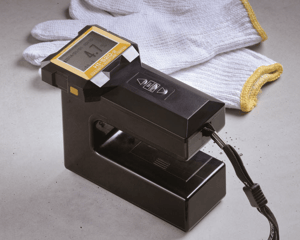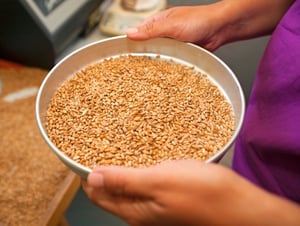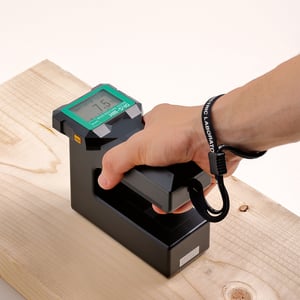 Selecting the right moisture meter for your needs can be a tricky task. Exactly what kind of moisture meter is right for you? Do you need something portable? An in-line moisture meter? Will it have multiple uses, and therefore multiple necessary calibrations? How much time do you have allotted for a moisture reading?
Selecting the right moisture meter for your needs can be a tricky task. Exactly what kind of moisture meter is right for you? Do you need something portable? An in-line moisture meter? Will it have multiple uses, and therefore multiple necessary calibrations? How much time do you have allotted for a moisture reading?
If you are in the market for a new moisture meter, one of the major decisions you will have to make is whether you want to purchase a loss-on-drying (LOD) moisture meter or a near infrared (NIR) moisture meter. Both have definite pros to using them, but many people will find that there is a definite better choice for them, depending on what they need their moisture sensor to do. Let’s take a look at what each moisture meter can do:
LOD Moisture Meters
When considering a loss on drying moisture meter, it is important to consider the idea that it is a primary measurement method. This means that it can measure the amount of liquid in nearly anything, without any kind of calibration. This is also the very first method for measuring the amount of moisture a subject contains.
The main concept behind LOD moisture meters is to compare the weight before, and after completely drying the sample. This should give a measurement of the moisture level within the test subject, or the “loss on drying.” This process can be done manually, by taking a measurement of the weight, drying the test subject, then weighing the subject again. In addition to manual LOD measurements, this process can be conducted using an automated system like a moisture determination balance
NIR Moisture Meters
A new type of moisture meter has emerged in recent years, known as a near-infrared (NIR) moisture meter. After a quick calibration, the NIR moisture meter measures the surface level of moisture, by reading how much light is reflected back to the NIR meter, making it a secondary measurement method. They’re a truly exciting development in the world of measuring moisture content, offering numerous functions and nearly instant readings.
So Which Should You Pick?
When determining the type of moisture meter that is right for you, several variables must be considered to decide which moisture meter best suits your needs. Here are a few items that should factor into your decision:
Time Requirements
If time is no concern, you may consider a LOD moisture meter, which can sometimes take upwards of 15-60 minutes, depending on the sample, for the subject to completely dry to obtain an accurate reading of the moisture level. However, no calibration is needed. NIR moisture meters can be much more instantaneous, requiring only a quick calibration, and then providing almost instant results.
Accuracy
Both meters have their definite strengths, and a few drawbacks in terms of providing accurate readings of moisture levels. LOD meters can take moisture readings of samples with very high levels of moisture; however, operator error can lead to inaccurate readings. Additionally, all volatiles are evaporated during the drying process, so moisture levels reflect the total liquid content, not just the water content. LOD meters operate on the assumption that all liquids present in your sample are water.
NIR moisture meters can determine the level of various substances, including fats, oils, and sugars, depending on the meter's calibration. They can be used to measure moisture levels in both liquids and solids. Something to consider, however, is that NIR meters only measure the moisture level at the surface. If you are concerned that your sample has different moisture levels throughout, you may need to consider using a LOD meter. Otherwise, NIR meters, once calibrated, are highly accurate and nearly insusceptible to operator error.
Portability
If portability is a concern, then your only real choice is a NIR sensor. NIR moisture meters are available in handheld, desktop, and in-line versions, while LOD drying ovens can be large and bulky, making them impractical for field use. NIR meters are much smaller, and many are designed specifically with portability in mind, and some are even battery-powered.
Industries
LOD moisture meters are commonly used in the food industry, pharmaceuticals, pulp and paper, and chemical companies. What do all these industries have in common? They are usually very controlled environments, where a general knowledge of the sample's composition already exists. NIR moisture sensors are used in food and grain processors, as well as in the tobacco and pharmaceutical industries, for pulp and paper, minerals, personal care products, chemicals, and textiles. Their use is more widespread due to the flexibility and portability that an NIR moisture meter offers.
Other Factors to Consider
When choosing a moisture meter, you need to determine whether it should be destructive or non-destructive. Because they require an entire sample to be totally dried, LOD moisture meters are destructive; the sample is no longer viable for use. The NIR moisture meter, however, is non-destructive and does not require drying the sample to obtain an accurate reading.
Another factor to consider is cost. LOD moisture meters can start small, around $2,000, with larger, more complex meters running around $15,000. For NIR meters, the price starts around $10,000, and can run upwards of $40,000. While both sensors are definite investments, the information that they provide can really become a priceless part of your manufacturing, packaging, or harvesting process.
If you need more assistance determining which moisture meter is right for you, don’t hesitate to contact us today. The team at Kett is passionate about our products and is happy to share knowledge with you to help you find the exact right moisture meter for your needs.


